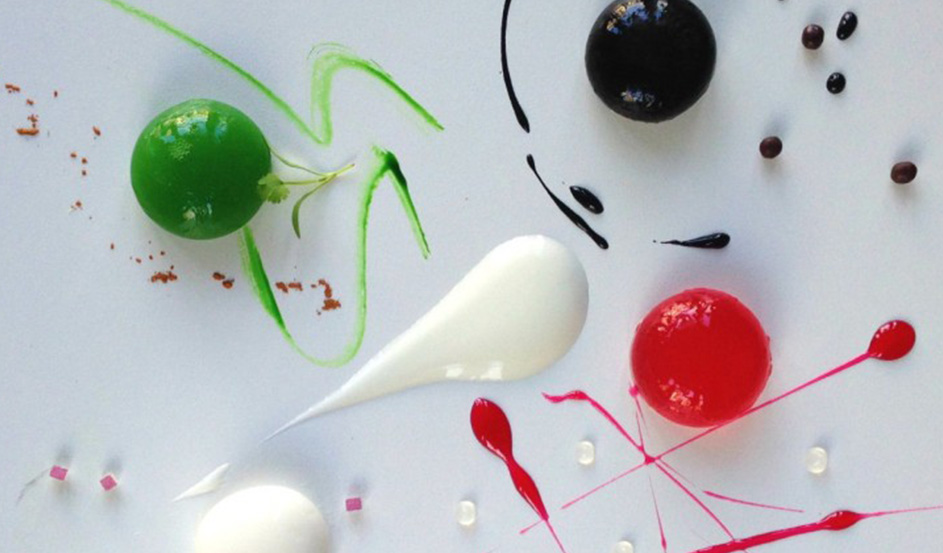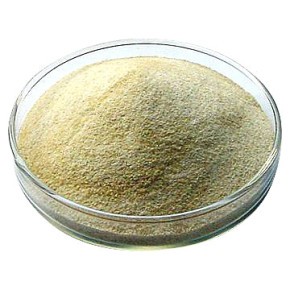
SODIUM ALGINATE & SPHERIFICATION
THE THICKENING AGENT – SODIUM ALGINATE

Sodium alginate (a food product derived from brown algae or seaweed) is a thickening and gelling agent that forms heat stable gels in the presence of calcium. This property allows cooks to make gelled spheres, in a technique known as spherification. Sodium alginate has been used in the food industry for many years for the production of gel-like foods – for example, the pimento stuffing in prepared cocktail olives. It is composed of long strands made up of carbohydrate units – these long stands allow it to act as a very efficient thickening agent at low concentrations (e.g. 1%). Gels formed from alginates have the amazing ability of withstanding heating to temperatures as high as 150ᵒC without melting, allowing them to be used in hot applications such as broths. When alginate is added to a liquid, it will act as a thickener. In the presence of calcium ions, a mixture containing alginate will form a gel. The calcium ions insert themselves between individual alginate strands and will allow them to interlock and form a gel.
SPHERIFICATION METHODS
There are two main methods for creating such spherification, which differ based on the calcium content in the product to be encapsulated in the gel bubble. For substances containing no calcium, a flavoured liquid is mixed with sodium alginate, and droplets of this mixture are dropped into a room temperature solution made up of water and calcium lactate or calcium gluconate (both are less bitter than other forms of calcium). ‘Reverse’ spherification, is a technique for use with substances which are rich in calcium, in this case additional calcium (if necessary) is blended into a flavoured liquid, and while the sodium alginate is blended into the water. Both methods give a similar result: a sphere of liquid held by a thin gel membrane, texturally similar to caviar.
BASIC SPHERIFICATION

Basic spherification is easier & ideal for obtaining spheres with an ultra thin membrane. The spheres are often referred to as caviar.
The Science
The flavoured spherification liquid cannot be too high in calcium or acidic (pH level must be above 3.6). A concentration of about 0.5% (approx. 5g to 1tr) sodium alginate is dispersed into the flavoured liquid (this will vary depending on the properties of the liquid being used). A concentration of around 1% (approx. 10g to 1ltr) calcium (either gluconate or lactate are advised – due to lack of perceivable bitter taste) is dissolved in water and is called a ‘water bath’.Equipment/ ingredients
- Sodium alginate
- Calcium lactate/gluconate
- Hand held immersion blender
- Pipette or syringe (for caviar)
- Precision scales (preferably 0.01g)
REVERSE SPHERIFICATION

Reverse spherification is more versatile and can be made in advance
The technique of Reverse Spherification is much more versatile than Basic Spherification as it can make spheres with almost any product. It is a simple reversal of basic spherification; the liquids in which the sodium alginate and calcium are dispersed in are reversed (i.e. calcium in the flavoured solution and alginate in the water bath). This process can be used to form spheres with liquids which are high in dairy, alcohol or acidity. There spheres can be made in advance and served later without compromising texture or flavour as the gelling process stops once the spheres are removed from the sodium alginate bath and ‘rinsed’ in water. The spheres will have a thicker membrane which is great for plating, however it does result in an added texture of a solid jelly membrane.
THE SCIENCE
Calcium is added to the flavoured liquid, the quantity will vary depending on the liquid’s natural calcium content, for a successful a total concentration of up to to 2% (approx. 20g to 1ltr) is required. The alginate ‘water bath’ is made using de-ionised water (so there is no calcium is present for the sodium alginate to start reacting with), and adding a concentration of approximately 0.5% (approx. 5g to 1ltr) of sodium alginate using a hand held immersion blender (aka a stick blender).
Equipment/ ingredients
- Sodium alginate
- Calcium lactate
- De-ionised water
- Precision scales (preferably 0.01g)
- Hand held immersion blender
- Rounded measurement spoons (for larger spheres)
Hints, tips, tricks
Avoid Clumping
This is most easily done by adding the powder in small increments, while mixing constantly with an electric hand blender. Make sure the powder doesn’t stick to the blending stick!
Disperse well!
Sodium alginate may take a while to disperse fully into solutions with a hand held immersion blender, this process may take up to 5 minutes.
Bubble free spheres
Leave the sodium alginate solution to rest in order for the trapped air bubbles to escape, this can take up to 24 hours
For basic spherification:
If the liquid in which the sodium alginate solution is too thick e.g. purees, mix the sodium alginate in water, then add to flavoured liquid
Mix the sodium alginate into 1/3 of the flavoured liquid, then add the rest of the liquid, this reduces the amount of air bubbles trapped in the solution as not all of it is aerated.
For reverse spherification:
Allow the sodium alginate bath to come to room temperature before using, to reduce the solution’s viscosity
Rotate the spheres while in the sodium alginate bath to ensure the full surface are of the sphere is ‘cooked’ equally and has a uniform membrane thickness on all sides
Consider calcium content
Do not mix sodium alginate into tap water or mineral water if it has a high calcium content as this will trigger the gelling process before you have even started. Use de-ionised water
Keep a the water bath clean
Keep the calcium (for basic spherification) or sodium alginate (for reverse spherification) ‘bath’ clean, any small particles floating around from previous spheres which have ruptured may disturb the process. Simply use a fine sieve to remove any particles
Correcting acidity for spherification
The Basic Spherification process does not work if the main ingredient is too acidic (PH<5). If necessary , the acidity can be reduced by adding sodium citrate to the main ingredient (if watery liquid) or the water used to reduce the main ingredient density (if thick liquid) always BEFORE you add the sodium alginate.

